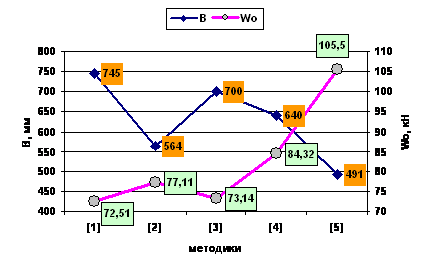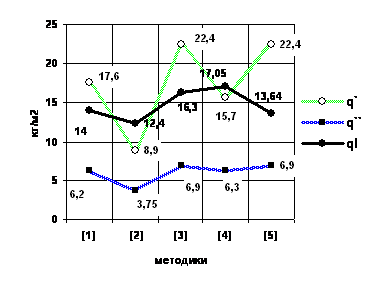 = 18 – conveyor belt gradient angle;
= 18 – conveyor belt gradient angle;

Email: yeryomenav@mail.ru
A great variety of conveyor belt haul applications has led to development of design procedures which are not, naturally, versatile. These procedures were worked out by different organizations. Some home and foreign design procedures and scientific studies of this area contain considerable contradictions, and some important studies haven’t been done up to the end or require additional elaboration. Coefficients intaken in different conveyor belt design procedures are not substantiated enough and fail to take into account actual working environment.
This research objective is to specify the coefficients and other characteristics influencing the conveyor belt design procedure. The following tasks are solved to achieve the above mentioned objective:
1. To study five different conveyor belt design procedures and to make the calculations with the help of MathCad programme.
2. To analyse and to compare the received computational results.
3. To introduce a procedure of determination of coefficients and other characteristics which are involved into conveyor belt design calculation.
This research examines made with the help of MathCad system calculations of five conveyor belt design procedures. To start the determination of the conveyor belt main characteristics we set the simplified conveyor belt design model and the following initial data:
Q=300t/hour – work output;
L=500m – transportation length;
V=2 m/c – belt working rate;
 = 18 – conveyor belt gradient angle;
= 18 – conveyor belt gradient angle;
 =25 – conveyor belt response angle.
=25 – conveyor belt response angle.
 =1 t/m3 – bulk load weight;
=1 t/m3 – bulk load weight;
 =30 mm – the largest pieces size;
=30 mm – the largest pieces size;
 =250 mm – bulk weight cargo.
=250 mm – bulk weight cargo.
The calculation was conducted according to the sequence shown in fig 1. The determination of conveyor belts characteristics was performed for the surface working conditions.

Fig.1. The sequence of conveyor belt main characteristics calculation.
Calculation findings were tabulated (Table 1). Table introduces the comparison of finding through their maximum-minimum values.
| Parameter | [1] | [2] | [3] | [4] | [5] | min | max | Difference |
|---|---|---|---|---|---|---|---|---|
| Bamax, мм | - | 700 | 700 | 750 | 700 | 700 | 750 | 7% |
| q,Н/м | 409 | 417 | 417 | 417 | 417 | 409 | 417 | 2% |
| Wпор, кН | - | -2154 | -2279 | -2329 | -2202 | -2202 | -2329 | 5% |
| Wгр, кН | - | 9785 | 9865 | 10160 | 10320 | 9785 | 10320 | 5% |
| Sнаб, кН | 10140 | 10149 | 9913 | 11810 | 13820 | 9913 | 13820 | 28% |
| Sсб, кН | 2885 | 2532 | 4747 | 3360 | 5436 | 2532 | 5436 | 53% |
While calculating the width of the conveyor line the difference in the calculation finding makes up 34% (Fig. 2). Such a difference in calculation findings is reached because of the substitution of the productivity coefficient into the formula. The given coefficient is the area of the line transported load cross-section. The productivity coefficient of the design procedures under analysis falls between 270 and 700. The difference intaken in the findings isn’t acceptable at all, that is why the coefficient of productivity needs some elaboration.

Fig.2. Calculation finding of belt width and general belt pressure drag according to the analyzing procedures
Calculation finding of the belt mass, in the conveyor belt design procedures under analysis vary within 27% (Fig.3). This characteristic was set the same for all the procedures, so it hasn’t influenced calculation findings. As the belt mass has an impact on the general belt pressure drag calculation, it, surely, requires refinement.

Fig.3. Linear load calculation finding
While calculating the linear load out of the mass of roller carriage rotating parts when the belt is loaded, , the difference in calculation finding is 30% (Fig.3). The reason is that the calculation with procedures [3] and [5] is done roughly with the empirical formulae. With the procedures [2] and [4] the mass of roller carriage rotating parts is selected according to the table while calculating this parameter. As the calculating formula for these procedures doesn’t have any differences, the calculation finding is the same. With procedure [1] the selected mass of the roller carriage rotating parts slightly differs from parameters in other procedures, the finding differs as well.
While calculating the general pressure drag, (Fig.3), the difference between the findings makes up 31% because of procedure [5] values. According to this procedure the calculation is done accounting onto the drag coefficient intaken for the underground mining environment; there’s no calculation for the surface environment. Also, while calculating according to this procedure there is the coefficient which allows for the values of lumped resistance (Fig.1). Calculation findings of with the procedures [1], [2] and [3] differ not more than by 1%. The general drag (resistance) calculated using the procedure [4] differs from the value of the procedure [1] by 14%. According to the procedure [4] the drag at the load point is calculated separately, and according to the other procedures this drag is allowed for the coefficients.
The general drag is later involved into the calculation of the rest conveyor belt characteristics (e.g. belt tension, engine power, etc.) So, the difference in the calculation finding of the general drag shifts onto the further calculations of other conveyor belt parameters.
The general analysis of the design procedures shows that the calculation sequence of all the considered procedures is analogous. The detailed analysis elicited that at nearly every step of the calculation each procedure has its own peculiarities for the determination of the main characteristics calculation. These peculiarities are not only in the difference in formulae the parameters calculation. The values of the standard characteristics (for example, the mass of the roller carriage rotating parts with the loaded or unloaded belt) and the coefficients (coefficient ?) selected from the tables of the analyzed procedures differ considerably. It greatly tells on the calculation results, this was revealed in the table of the conveyor belt main characteristics findings.
The comparison of the obtained data was made taking into account the maximum-minimum values. As a result, the difference in the calculation procedures makes up from 2 to 53%. Such dispersion in the findings when selecting the conveyor belt according to the design value can have a considerable impact onto the operational and productivity factors.
This implies that it is necessary to specify the actual coefficients intaken according to the procedures tables. It is also required to use the actual data referred to the choice of rollers and belts. From the theoretical point of view it is essential to elaborate the general drag calculation which is done with different degree of actual working environment specification in the procedures under analysis. It is evident with calculation according to the design procedure [4], where the drag on the load point is calculated separately, and it affects the calculation of the general drag.
Literature
1."Справочник по проектированию ленточных конвейеров" О.В.Зеленский, А.С.Петров. -М.: 1986. -223с.
2."Расчет ленточных конвейеров для шахт и карьеров" Л.Г.Шахмейстер, В.Г.Дмитриев. -М.: 1972. -300с.
3."Транспорт на горных предприятиях" Б.А.Кузнецов, -М.: 1976. -552с.
4."Расчеты грузоподъемных транспортирующих машин" Ф.К.Иванченко, В.С.Бондарев, Н.П.Колесник, В.Я.Барабанов -М.: 1978. -523c.
5."Теоретические основы и расчеты транспорта энергоемких производств" В.А.Будишевский,А.А.Сулима. -Донецк.: 1999. -216c.
6. "Подземные конвейерные установки"Л.Г.Шахмейстер, Г.И. Солод -М.1976. -432с.
7. "Конвейеры: Справочник" Р.П.Зенков, В.К.Дьячков -Л.: 1984. -367с.
8. "Машины непрерывноготранспорта" В.И.Плавинский.-М.: 1977. -719с.
9. "Машины непрерывного транспорта" Учебное пособие для студентов, Р.П.Зенков, И.И.Иванов, Л.Н.Гнутков. -М.: 1980. -304с.
|
Biography |
Links |
Library |
Report about the search |
Individual task |